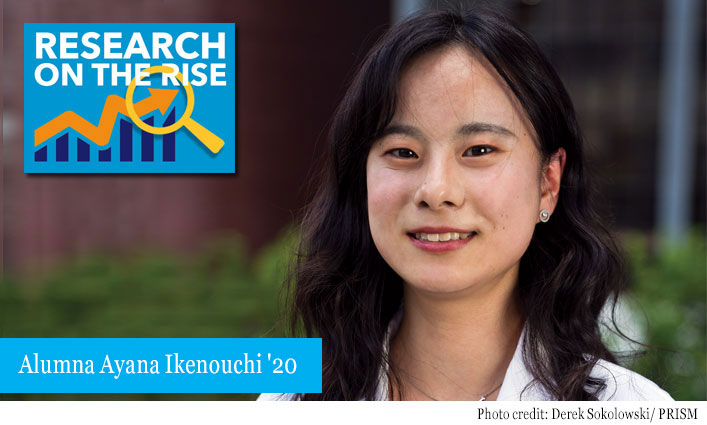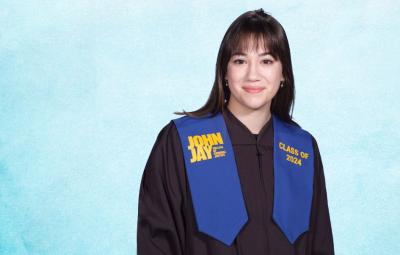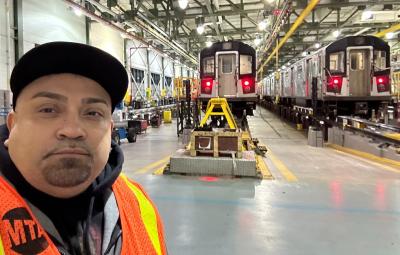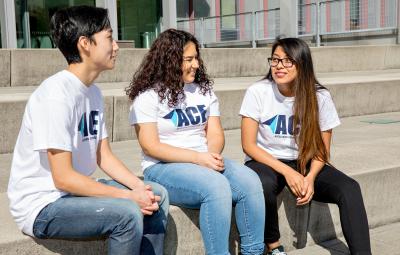
“Research sits at the core of our mission to educate for justice,” says President Karol V. Mason. The remarkable research that our esteemed faculty, students, and alumni perform directly impacts our society and helps move the needle forward toward creating a more just world. Their empirical data reveals inconsistencies, pushes boundaries, and opens minds to a whole new way of thinking. Our “Research on the Rise” series aims to showcase the ongoing, upcoming, and noteworthy research happening right here at John Jay.
During her time with John Jay’s Program for Research Initiatives in Science and Math (PRISM), alumna Ayana Ikenouchi ’20 relished the opportunity to conduct research with Associate Professor Richard Li, Ph.D., an expert on DNA analysis. Ikenouchi’s interest in the study of DNA stems from witnessing the devastating impact the 2011 tsunami had on her native Japan. “I will never forget how it was forensic science and the analysis of DNA samples that led to many missing people being identified. Because of the DNA, their bodies were returned to their families. So, from the moment I read Dr. Li’s research on DNA, I knew I wanted to work with him,” says Ikenouchi, crediting Li’s work on developing an innovative and less invasive way to extract DNA from decayed bones—a process that required less physical force and could lead to a larger pool of analysis—with opening her eyes to all the possibilities research offers. At John Jay, Ikenouchi got the chance to do just that, working with Li to develop new ways to identify sus species, or pigs, with the goal of identifying the host of the swine virus and preventing food adulteration. We sat down with Ikenouchi to learn more about her research and hopes for the future.
“Science is everywhere and in everything.” —Ayana Ikenouchi
Seeing Science in Everything
Ikenouchi can remember the exact moment she became fascinated by the world of science. She was sitting in class in her hometown of Osaka, Japan, and her teacher began to show how colors can change because of a simple chemical reaction. “That observation really impacted me because it showed me that science is everywhere and in everything,” says Ikenouchi, who went on to attend a “super science high school” where she conducted research on how cicadas are impacted by global warming and how they affect the environment. But it was a natural disaster in Japan that would have the biggest influence on Ikenouchi, putting her on the path toward forensic science research in the U.S. “A big earthquake in Tohoku led to a tsunami. A lot of people were missing and when their bodies were found they could not be identified just by looking at them, so the body could not go back to their family,” says Ikenouchi. “At that point, forensic science comes in, and DNA identification starts to happen. By using DNA samples, a lot of people were identified, and their bodies went back to their families. If someone you love is missing, you cannot move on, you cannot get closure. But once they were found, and DNA samples helped identify them, it provided the families with peace and a chance to move forward.”
“I came to the U.S. because I wanted to go to a good forensic science program, I wanted to conduct research, and I wanted a good support system. I found all those things at John Jay and PRISM.” —Ayana Ikenouchi
Embracing Research at John Jay
Transformed by her experience back home, Ikenouchi was ready to pursue a path in forensic science and research, and she decided to study in the U.S. “In Japan, the forensic science major doesn’t exist. I came to the U.S. because I wanted to go to a good forensic science program, I wanted to conduct research, and I wanted a good support system. I found all those things at John Jay and PRISM,” she says. Providing insight on the work that inspired her to come to the College, Ikenouchi breaks down Li’s work on extracting DNA from decayed bones. She explains that bones, which are made of protein, contain DNA inside of them and in order to get to the DNA you need a chemical reaction to occur. “Dr. Li used an enzyme to cause a chemical reaction that digests the protein of the bone without harming the DNA. The enzyme opens the bone up so that DNA can be extracted without being harmed. He was able to get purified DNA using this method,” says Ikenouchi.
Conducting Research Amid Covid-19
Li’s research in DNA inspired Ikenouchi so much that she wanted to make it an integral part of their collaborative research on pig species identification. “We know how to extract DNA using Dr. Li’s enzymatic method and I wanted to do that with all the different sus species,” explains Ikenouchi, who used DNA sequences to build phylogenetic trees, that would determine the differences between each pig species. She had two major goals for the project in mind, the first being that it would help reduce the level of food adulteration, or food fraud, happening in the country. “Many people eat meat, meat from pigs or beef. Sometimes on the label it will say it’s pig, and you assume it’s true and safe, but it isn’t. There could be different meats in the package,” she says, suggesting that this kind of intentional mislabeling, food mixing, or misrepresentation can cause harm.
Her second goal was to shed light on the origins of the swine virus. Ikenouchi explained that if they could identify the same protein in the virus and in the DNA sequence of each of the pig species, they could find the virus’s possible original host. Another virus, however, would put a twist on their research. Because of the pandemic, they couldn’t collect all the data they needed in the lab. Li suggested they pivot and look to the data that was available. “I was able to use DNA sequences from the National Center for Biotechnology Information database and from Dr. Li’s own collected data,” says Ikenouchi. “I analyzed the DNA sequences using the Molecular Evolutionary Genetics Analysis [MEGA X] and was able to construct many phylogenetic trees and identify different sus species.” While the research couldn’t be conducted in the way they originally hoped, Ikenouchi is proud of what her and Li were able to accomplish. “We could not identify all the sus species because of Covid, but we believe that using our research method in the future will help identify all of them, and lead to the prevention of food adulteration and the identification of the host of swine virus.”
“Before conducting research at John Jay, I thought forensic science research was only for crime scenes and natural disasters, but now I know it’s a field that can be used in so many ways to help so many people.” —Ayana Ikenouchi
Feeling Grateful for Collaborative Work
When she thinks about her time at John Jay, Ikenouchi appreciates the opportunities the College offered her, but she’s especially grateful to Li, who helped her find her footing in research. “Dr. Li taught me a lot of things. He taught me how to do research, how to write a research paper, what to look for when you’re developing your research methods and working on each section of your investigation. Even after I graduated, we still keep in touch. I ask him what classes I should take in grad school and what courses would be good for me if I wanted to do a Ph.D. He’s really a mentor for my life,” says Ikenouchi. “Before conducting research at John Jay, I thought forensic science research was only for crime scenes and natural disasters, but now I know it’s a field that can be used in so many ways to help so many people. And it gives me more possibilities to conduct more research.”
“I want to learn how differences in our DNA sequence can cause diseases. If we can identify the differences, then we can find ways to counter the disease, we can treat people, and maybe even save lives.” —Ayana Ikenouchi
Looking ahead, Ikenouchi is on track to earn her master’s degree in Biology/Biological Sciences from Hunter College, and then possibly go on to pursue her doctorate. After that, she plans to continue conducting research and changing the education system in her native Japan. “I have two big dreams for my life. One is to make a positive impact on the Japanese education system. I want to launch forensic science programs and majors across the universities there. And, my second dream is to continue to do research, especially medical DNA research. I want to learn how differences in our DNA sequence can cause diseases. If we can identify the differences, then we can find ways to counter the disease, we can treat people, and maybe even save lives.”



